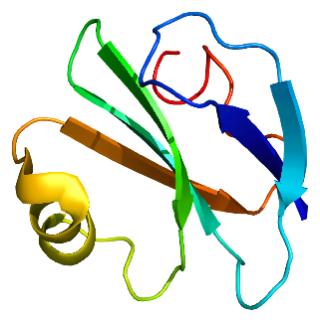MAC-IP (CD59)
MAC-IP (MAC-inhibitory protein), also known as CD59 or membrane inhibitor of reactive lysis (MIRL), is a cell surface glycoprotein that in humans encoded by the CD59 gene. This gene spans over 20 kb of DNA and contains four exons. The precursor protein encoded by the CD59 gene has 128 amino acids, 25 of which are amino-terminal signal peptides, and 26 amino acid hydrophobic sequences at the carboxyl-terminal, which provide signals for GPI anchoring. The mature protein contains a backbone of 77 amino acids with the GPI anchor attached to Asn77. The structure of CD59 in solution was recently determined by NMR spectroscopy. The protein is folded into a disk-like domain with clustered desulfur bonds at the hydrophobic center and four ring-like extensions protruding from the disk.
 Fig. 1 The structure of human CD59.1
Fig. 1 The structure of human CD59.1
MAC-IP is a crucial regulator that protects autologous cells from the terminal effector mechanism of the complement cascade. MAC-IP can bind to C8 in the C5b-8 complex and block the uptake and polymerization of C9, interfering with the assembly of a fully functional MAC, thereby inhibiting the formation of cytolytic pore on host cell surfaces. Sometimes, MAC-IP may also bind to C9 in partially assembled MAC complexes. Besides, MAC-IP has been revealed to be involved in lymphocyte signal transduction. MAC-IP can bind to human CD2, leading to T cell costimulation. Mutations with loss of function in the CD59 gene are associated with several diseases such as hemolytic anemia, thrombosis, and cerebral infarction.
Reference
-
From Wikipedia: By Emw - Own work, CC BY-SA 3.0 https://commons.wikimedia.org/wiki/File:Protein_CD59_PDB_1cdq.png
For Research Use Only.

 Fig. 1 The structure of human CD59.1
Fig. 1 The structure of human CD59.1